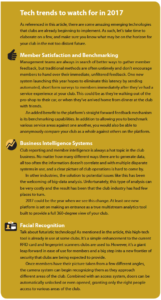Belonging to, or even visiting a club, comes with certain expectations. One of which is that an elevated level of service will be experienced. In order to deliver on these expectations, clubs are turning to sophisticated technology applications not only to streamline tedious and time consuming tasks, but also to elevate the level of service offered.
Now, at the beginning of 2017, the boundaries are being pushed even further in terms of the technological possibilities within the club industry. There are general managers who are exploring how they can automate the delivery of single-question member surveys based on member transactions at the club. In other cases, clubs are implementing facial recognition software—especially helpful in one particular case at a large athletic club where young members often arrive with bags full of sports equipment, and may struggle to swipe a card or scan a finger.
As a whole, this is a good thing. Technology investment can deliver much in the way of operational performance as well as member facing service. However, a common problem for many businesses is the creation of information silos.
 With each new technology layer that we add at our clubs, we create the possibility of a breakdown in information sharing—either through broken automation or at the hands of failed manual communication processes. In other cases, where a complete overhaul of technology infrastructure is considered, the individual departments within a club may want to develop their own ways of storing, managing and relaying information. Eventually, if these multiple business areas are left to operate with just their own unique set of requirements in mind, the same breakdown in overall communication occurs.
With each new technology layer that we add at our clubs, we create the possibility of a breakdown in information sharing—either through broken automation or at the hands of failed manual communication processes. In other cases, where a complete overhaul of technology infrastructure is considered, the individual departments within a club may want to develop their own ways of storing, managing and relaying information. Eventually, if these multiple business areas are left to operate with just their own unique set of requirements in mind, the same breakdown in overall communication occurs.
Information silos are a common issue when businesses choose to implement multiple disparate systems in an effort to satisfy the needs of these individual business areas. The breakdowns that can result cause additional work for staff when information needs to be entered multiple times. Additionally, when staff don’t readily have access to information, this can have a negative impact on the service experience. For example, when a member asks for an itinerary of all their upcoming bookings, staff shouldn’t need to access multiple systems in order to fulfill the request. Or when a member is seated in the dining room, staff should be automatically alerted to that member’s preferences or even allergies.
A final consideration, and one which is easily overlooked, is the potential business impact of seemingly straight forward system updates. When one vendor issues a product update, interfaces to other systems can encounter any number of issues, the worst of which could leave an area of your business disabled. In cases such as this, clubs often become the first line of quality assurance as vendors work to re-establish connections through their various interfaces.
All types of industries suffer from issues such as these, and when they reach a tipping point, businesses often look to the implementation of enterprise management systems, the theory of which is straightforward:
“A single system designed to meet the needs of an entire organization rather than the interests of individual users.”
Most enterprise systems are essentially large platforms comprised of many smaller, business specific applications, all of which are designed to work together and share a single database. In most cases, these smaller applications are likely to be updated multiple times each year, and grow significantly in functionality over time.
The enterprise model seems like an obvious choice to eliminate information silos; unfortunately with any large system, specialized knowledge may be required and many businesses rely heavily on existing staff knowledge to train new users. What results is an ever-growing information gap between the initial implementation and training and the current users’ level of competence—this is referred to as the knowledge deficit. A growing knowledge deficit over time will ultimately result in a massive underutilization of the technology in place.
Ultimately, when dealing with multiple individual systems or a single enterprise system, business objectives change over time and the underlying technology should be evaluated and refined to meet your current needs. After all, the most successful clubs are ones that maximize their technology investments by taking the time to establish correct processes, make investments in ongoing education, and aren’t afraid to ask their vendors questions. No matter how advanced the technology you put in place may be, no system can run your club for you. That’s up to you and your team.
Trevor Coughlan is director of marketing at Jonas Club Software. He can be reached at 800-352-6647 ext. 2278 or trevor.coughlan@jonasclub.com.


